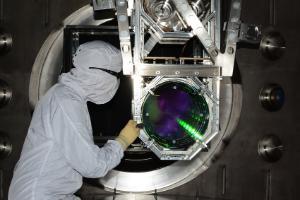University plays key role in gravitational wave detector launch
Published: 19 May 2015
A major research project to find evidence of the existence of gravitational waves is being officially launched today (Tuesday 19 May).
A major research project to find evidence of the existence of gravitational waves is being officially launched today (Tuesday 19 May).
The Advanced Laser Interferometer Gravitational-wave Observatories (aLIGO) project, based at the LIGO Hanford facility in Richland, Washington, USA, is an upgrade to an existing detector, which University of Glasgow researchers have played a major role in developing.
Gravitational waves are ripples in space-time that are emitted by cataclysmic cosmic events such as exploding stars, merging black holes and/or neutron stars, and rapidly rotating compact stellar remnants.
The existence of gravitational waves was predicted in 1916 by Albert Einstein as a consequence of his general theory of relativity but the waves have never been observed directly.
The first LIGO detector looked for gravitational waves between 2002 and 2010. The 4-km-long. L-shaped LIGO interferometers use a laser split into two beams that travel back and forth down long beam tubes from which the air has been evacuated. The beams are used to monitor the distance between precisely configured mirrors. According to Einstein's theory, the relative distance between the mirrors will change very slightly when a gravitational wave passes by.
The original configuration of LIGO was sensitive enough to detect a change in the lengths of the 4-km arms by a distance one-thousandth the size of a proton. The new detector will increase the sensitivity of the LIGO instruments by a factor of 10 and provide a 1,000-fold increase in the number of astrophysical candidates for gravitational wave signals. The aLIGO instruments should detect multiple gravitational-wave events each year.
The first direct detection of gravitational waves will open a new window to the otherwise invisible ‘dark’ side of the Universe and mark the beginning of an entirely new form of gravitational-wave astronomy.
Researchers from the University of Glasgow’s Institute for Gravitational Research (IGR) have played a vital role in developing key aLIGO systems as part of the British-German GEO initiative. The GEO600 is an interferometric gravitational-wave detector with 600 meter long laser beam tubes, located near Hannover, Germany.
Along with the University of Birmingham and the Rutherford Appleton Laboratory, and collaborators from University of Strathclyde, IGR researchers supplied the suspension technology which holds the interferometer’s mirrors in place and part of its optical system. The team will also prepare data analysis computing systems in readiness for engineering and science data runs scheduled to start later in the year. The research was funded by the Science and Technology Facilities Council (STFC).
Professor Kenneth Strain is deputy director of the Institute for Gravitational Research at the University of Glasgow and principal investigator of the Advanced LIGO project team in the UK.
He said: "The aLIGO project is immensely important in developing our understanding of the universe, and we’re pleased and proud to have been involved from the start following our close involvement with the original LIGO initiative.
“I am delighted that the precision fused-silica suspensions, developed from those in the GEO600 detector and upgraded to carry 40-kg mirrors, have been successfully integrated into the Advanced LIGO detectors. This opens the way for observing to start in the near future."
Professor Sheila Rowan, director of the Institute for Gravitational Research, said: “With data coming soon from the advanced detector network we are planning for the future - the benefits of cooling to reduce noise in suspension systems is an area of research to be pursued over the next few years. This is of relevance to future detector upgrades and designs, and the group plays a leading part in a pan-European consortium carrying out a design study for a potential future third-generation gravitational wave detector - the 'Einstein Telescope' - which may employ this, and other novel technologies."
Prof. Karsten Danzmann, director at the Max Planck Institute for Gravitational Physics (Albert-Einstein-Insitute/AEI) and director of the Institute for Gravitational Physics at the Leibniz Universität Hannover, said: ““With our UK colleagues we designed and operate the gravitational-wave detector GEO600 near Hanover, Germany. We use it as a think tank and testbed for advanced detector techniques.
“Many of these new methods are now in use at the aLIGO detectors, such as signal recycling and monolithic mirror suspensions.”
As well as having participated in searches for gravitational wave sources in the initial detector network, GEO600 plays a pioneering role in the development and application of non-classical light in gravitational-wave detectors. GEO600 is the only detector worldwide using squeezed light to improve the detector sensitivity beyond limits set by the quantum nature of light.
aLIGO will start its first data-taking (observation) run “O1” in the autumn of 2015, bringing the era of gravitational-wave astronomy a large step closer to reality.
Media enquiries: ross.barker@glasgow.ac.uk / 0141 330 3535
First published: 19 May 2015
<< May

